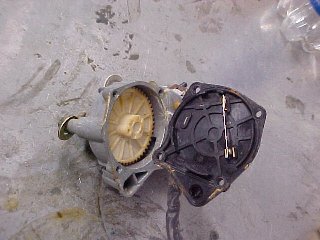 FAQ Project. |
MOTOR RETROFIT James Seabolt updated 05/30/05 |
 FAQ Project. |
MOTOR RETROFIT James Seabolt updated 05/30/05 |
 Blue/Black --> Always hot when ignition switch is on
Blue/Black --> Always hot when ignition switch is on The trick was to isolate the finger that is grounded to the body and
solder a six wire to it. I took a some wire cutters and cut the tab
and bent it so that it did not touch any of the other wires or the body
of the wiper motor. Also notice that I trimmed off a section of the
motor which was used as a support bracket for the VW wiper linkage.
When I linked the wires from the car's wiring
harness to the wiper motor, I used 12 AWG wire. This may be overkill.
Just don't use anything thinner than 14 AWG.
The trick was to isolate the finger that is grounded to the body and
solder a six wire to it. I took a some wire cutters and cut the tab
and bent it so that it did not touch any of the other wires or the body
of the wiper motor. Also notice that I trimmed off a section of the
motor which was used as a support bracket for the VW wiper linkage.
When I linked the wires from the car's wiring
harness to the wiper motor, I used 12 AWG wire. This may be overkill.
Just don't use anything thinner than 14 AWG.
 Here is a photo of the Marelli motor's gear cover removed. These should
be the same on all Fiats except for the number of wires
used. On five wire motors, one of the contacts will be grounded. So
there is no need to break the tab on the back of the Bosch motor and
solder an extra wire.
Here is a photo of the Marelli motor's gear cover removed. These should
be the same on all Fiats except for the number of wires
used. On five wire motors, one of the contacts will be grounded. So
there is no need to break the tab on the back of the Bosch motor and
solder an extra wire.